
Dartmoor tin-mining
Encyclopedia

Roman Empire
The Roman Empire was the post-Republican period of the ancient Roman civilization, characterised by an autocratic form of government and large territorial holdings in Europe and around the Mediterranean....
times, and continued right through to the 20th century. From the 12th century onwards tin mining was regulated by a Stannary Parliament
Stannary Courts and Parliaments
The Stannary Parliaments and Stannary Courts were legislative and legal institutions in Cornwall and in Devon , England. The Stannary Courts administered equity for the region's tin-miners and tin mining interests, and they were also courts of record for the towns dependent on the mines...
which had its own laws.
Tin
Tin
Tin is a chemical element with the symbol Sn and atomic number 50. It is a main group metal in group 14 of the periodic table. Tin shows chemical similarity to both neighboring group 14 elements, germanium and lead and has two possible oxidation states, +2 and the slightly more stable +4...
is smelted
Smelting
Smelting is a form of extractive metallurgy; its main use is to produce a metal from its ore. This includes iron extraction from iron ore, and copper extraction and other base metals from their ores...
from cassiterite
Cassiterite
Cassiterite is a tin oxide mineral, SnO2. It is generally opaque, but it is translucent in thin crystals. Its luster and multiple crystal faces produce a desirable gem...
, a mineral
Mineral
A mineral is a naturally occurring solid chemical substance formed through biogeochemical processes, having characteristic chemical composition, highly ordered atomic structure, and specific physical properties. By comparison, a rock is an aggregate of minerals and/or mineraloids and does not...
found in hydrothermal veins in granite
Granite
Granite is a common and widely occurring type of intrusive, felsic, igneous rock. Granite usually has a medium- to coarse-grained texture. Occasionally some individual crystals are larger than the groundmass, in which case the texture is known as porphyritic. A granitic rock with a porphyritic...
, and the uplands of Dartmoor
Dartmoor
Dartmoor is an area of moorland in south Devon, England. Protected by National Park status, it covers .The granite upland dates from the Carboniferous period of geological history. The moorland is capped with many exposed granite hilltops known as tors, providing habitats for Dartmoor wildlife. The...
, in Devon
Devon
Devon is a large county in southwestern England. The county is sometimes referred to as Devonshire, although the term is rarely used inside the county itself as the county has never been officially "shired", it often indicates a traditional or historical context.The county shares borders with...
, England
England
England is a country that is part of the United Kingdom. It shares land borders with Scotland to the north and Wales to the west; the Irish Sea is to the north west, the Celtic Sea to the south west, with the North Sea to the east and the English Channel to the south separating it from continental...
, were a particularly productive area. The techniques used for the extraction of tin from Dartmoor followed a progression from streaming through open cast mining to underground mining. Today, there are extensive archaeological remains of these three phases of the industry, as well as of the several stages of processing that were necessary to convert the ore to tin metal.
Stannary laws

Mining
Mining is the extraction of valuable minerals or other geological materials from the earth, from an ore body, vein or seam. The term also includes the removal of soil. Materials recovered by mining include base metals, precious metals, iron, uranium, coal, diamonds, limestone, oil shale, rock...
became such an important part of life in the region that as early as the 12th century, tin miners developed their own set of laws (stannary
Stannary
The word stannary is historically applied to:*A tin mine, especially in Cornwall or Devon, South West England*A region containing tin works *A chartered entity comprising such a region, its works, and its workers...
laws) and, ultimately, their own parliaments (Stannary Parliaments). These laws applied to anyone involved in the industry.
Stannaries were established in Tavistock, Ashburton and Chagford
Chagford
Chagford is a small town and civil parish on the north-east edge of Dartmoor, in Devon, England, close to the River Teign. It is located off the A382, about 4 miles west of Moretonhampstead. The name Chagford is derived from the word chag, meaning gorse or broom, and the ford suffix indicates its...
by King Edward I
Edward I of England
Edward I , also known as Edward Longshanks and the Hammer of the Scots, was King of England from 1272 to 1307. The first son of Henry III, Edward was involved early in the political intrigues of his father's reign, which included an outright rebellion by the English barons...
in 1305. Plympton
Plympton
Plympton, or Plympton Maurice or Plympton St Maurice or Plympton St Mary or Plympton Erle, in south-western Devon, England is an ancient stannary town: an important trading centre in the past for locally mined tin, and a former seaport...
followed soon after. The Devon stannary parliament met in an open air forum at Crockern Tor
Crockern Tor
Crockern Tor is a tor in Dartmoor National Park, Devon, England. Composed of two large outcrops of rock, it is 396 metres above sea level. The lower outcrop was the open-air meeting place of the Devonshire Stannary Parliament from the early 14th century until the first half of the 18th century...
from 1494.
Anyone who broke a stannary law could find himself imprisoned in the gaol at Lydford
Lydford
Lydford, sometimes spelled Lidford, is a village, once an important town, in Devon situated north of Tavistock on the western fringe of Dartmoor in the West Devon district.-Description:The village has a population of 458....
. The stannary courts were abolished in 1836.
Geology
The majority of the tin mines on Dartmoor are located in granite country rockCountry rock (geology)
Country rock is a geological term meaning the rock native to an area. It is similar and in many cases interchangeable with the terms basement and wall rocks....
and most of the lode
Lode
In geology, a lode is a deposit of metalliferous ore that fills or is embedded in a fissure in a rock formation or a vein of ore that is deposited or embedded between layers of rock....
s trend ENE–WSW and are of limited length, though there are exceptions. In the underground workings, the tin ore, cassiterite
Cassiterite
Cassiterite is a tin oxide mineral, SnO2. It is generally opaque, but it is translucent in thin crystals. Its luster and multiple crystal faces produce a desirable gem...
, was usually found in association with large amounts of tourmaline
Tourmaline
Tourmaline is a crystal boron silicate mineral compounded with elements such as aluminium, iron, magnesium, sodium, lithium, or potassium. Tourmaline is classified as a semi-precious stone and the gem comes in a wide variety of colors...
, and in central Dartmoor with much specular haematite. In the southern part of the moor, the cassiterite was usually found in relatively large grains, but the lodes were of very variable quality. These factors, combined with the fact that none of the underground workings was found to be profitable at depth, are typical of the deepest zone of tin mineralisation. The once very extensive alluvial deposits
Alluvium
Alluvium is loose, unconsolidated soil or sediments, eroded, deposited, and reshaped by water in some form in a non-marine setting. Alluvium is typically made up of a variety of materials, including fine particles of silt and clay and larger particles of sand and gravel...
of tin ore, that were the first deposits to be mined, also point to the vast quantity of ore that once existed in lodes that have been eroded from above the granite since it was emplaced in the Carboniferous
Carboniferous
The Carboniferous is a geologic period and system that extends from the end of the Devonian Period, about 359.2 ± 2.5 Mya , to the beginning of the Permian Period, about 299.0 ± 0.8 Mya . The name is derived from the Latin word for coal, carbo. Carboniferous means "coal-bearing"...
period.
Streaming
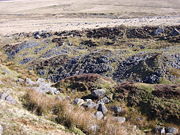
Lode
In geology, a lode is a deposit of metalliferous ore that fills or is embedded in a fissure in a rock formation or a vein of ore that is deposited or embedded between layers of rock....
s. The geological processes that resulted in the deposition of the cassiterite in the stream beds often resulted in very pure tin gravel which was mixed with gravels of other, unwanted, minerals such as quartz, mica and feldspar, collectively known an "gangue". It was relatively easy to separate these minerals on the basis of their very different specific gravities
Specific gravity
Specific gravity is the ratio of the density of a substance to the density of a reference substance. Apparent specific gravity is the ratio of the weight of a volume of the substance to the weight of an equal volume of the reference substance. The reference substance is nearly always water for...
– cassiterite about 7 and gangue 3 or less. The separation was performed by passing a stream of water over the gravels: the gangue would be washed away faster than the wanted tin gravel.
Once a tin-bearing valley had been identified, the stream-workers would arrange a stream of water, probably carried by a leat
Leat
A leat is the name, common in the south and west of England and in Wales, for an artificial watercourse or aqueduct dug into the ground, especially one supplying water to a watermill or its mill pond...
from higher up the valley, and starting at the lowest end of the deposit they would dig a trench (known as the "tye") as deep as possible to allow the finer gangue to be washed away. From there they would start working up the valley, using the stream of water to wash over the debris they had loosened from the bed with picks. This method of working leaves characteristic evidence in the valleys - a series of ridges of the larger gangue material, sometimes roughly perpendicular to, sometimes coaxial with the line of the valley, sometimes apparently haphazard, all bounded by a scarp which marked the edge of the worked ground and whose height relates to the depth of the deposits.
Eluvial deposits
Eluvium
Eluvium is the moniker of ambient recording artist Matthew Cooper, who currently resides in Portland, Oregon. Cooper, who was born in Tennessee and raised in Louisville, Kentucky before relocating to the Northwest, is known for blending various genres of experimental music including shoegaze,...
—those that had weathered from the lode in the usual way, but had not then been transported by flowing water—were also worked; these tended to be poorer deposits due to the lack of sorting that a stream provides, and they usually did not have such a ready supply of water available to work them. They are found on gently-sloping hillsides. Where possible the water needed to work these deposits was carried by a leat from the nearest available river, or if the site was above such supplies, reservoirs were constructed to collect rainwater and runoff from hillsides.
A study has shown that a phase of aggradation
Aggradation
Aggradation is the term used in geology for the increase in land elevation due to the deposition of sediment. Aggradation occurs in areas in which the supply of sediment is greater than the amount of material that the system is able to transport...
occurred in the Erme valley
River Erme
The Erme is a river in south Devon, England. From its source on Dartmoor it flows in a generally southerly direction past some of the best-preserved archaeological remains on the moor. It leaves the moor at the town of Ivybridge and continues southward, passing the settlements of Ermington, Modbury...
between the 4th century and 7th century, providing evidence of late Roman
Roman Empire
The Roman Empire was the post-Republican period of the ancient Roman civilization, characterised by an autocratic form of government and large territorial holdings in Europe and around the Mediterranean....
or early post-Roman tin mining activity in this valley. The same study confirmed what documentary evidence also relates: that there was a boom in tin production in the 13th century. The earliest written record of tin streaming comes from the 12th century.
Open cast
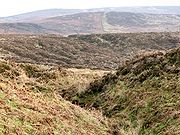
Another method of surface mining involved digging pits at intervals along the lode – this was known as "lodeback-work". At times these pits were dug in pairs along the back of the lode and the lode followed underground between them. This may have been the precursor to beamworks in a number of locations, but enough lodeback pits survive to indicate that it was a separate technique. The issue that mine managers had to decide was whether it was worth removing the extra overburden to form a gulley in order to be able to mine deeper into the lode.
In a similar fashion to streamworking, much use was made of water for the removal of the overburden and gangue. When digging large gullies the overburden, which consisted at least partly of decomposed granite ("growan"), was loosened with picks, and then water was used to wash away the unwanted material instead of manhandling it. Means of collecting, diverting and storing water were always associated with openworks. In some cases when only poor sources of water were available complex systems of reservoirs were built.
Underground
The Dartmoor tin industry declined in importance during the early 18th century and had fallen to nothing by 1730. This was due to a number of factors, but the most important was likely to be the exhaustion of the easily-accessible deposits. It was not until the Industrial RevolutionIndustrial Revolution
The Industrial Revolution was a period from the 18th to the 19th century where major changes in agriculture, manufacturing, mining, transportation, and technology had a profound effect on the social, economic and cultural conditions of the times...
fuelled demand for all metals and also provided the technology to mine them that mining resumed on the moor on any scale.
Although underground mining technology had been available for many centuries, it is likely that the joint problems of the hardness of the granite rock and the preponderance of underground water together with the relatively easy pickings from near the surface made deep mining not viable until the late 18th century.
Many small mining enterprises started up on Dartmoor in the late 18th and 19th centuries – 48 mines are known to have produced some tin during this period. Many of these ventures were unsuccessful, despite being given optimistic names like Wheal Fortune, Wheal Lucky and Wheal Prosper (the common prefix Wheal is a Celtic
Celtic languages
The Celtic languages are descended from Proto-Celtic, or "Common Celtic"; a branch of the greater Indo-European language family...
word meaning mine or works). Some larger mines, however, such as Eylesbarrow
Eylesbarrow mine
Eylesbarrow mine was a tin mine on Dartmoor, Devon, England that was active during the first half of the 19th century. In its early years it was one of the largest and most prosperous of the Dartmoor tin mines, along with Whiteworks mine and the Birch Tor and Vitifer mines. Its name has several...
and the Vitifer – Birch Tor complex
Birch Tor and Vitifer mine
Birch Tor and Vitifer mine was a tin mine on Dartmoor, Devon, England. Located in the valley of the Redwater Brook, to the east of the B3212 Moretonhampstead to Princetown road, below the Warren House Inn, the mine was worked between the mid–18th century and 1925.-History:In medieval times, or even...
were productive for many years.
Virtually all of the underground mines re-worked lodes that had been already been mined from the surface. Because of the great quantity of underground water, it was necessary to dig horizontal adits into the hillsides to de-water the mines. Dartmoor's topography, cut with deep valleys, helped here and in many cases it was possible to dig to a reasonable depth without the need to pump out water. These adits connected with shafts that were either sunk vertically downwards or followed the line of the steeply dipping lode. Working the lode then took place by stoping
Stoping (mining method)
Stoping is the removal of the wanted ore from an underground mine leaving behind an open space known as a stope. Stoping is used when the country rock is sufficiently strong not to cave into the stope, although in most cases artificial support is also provided...
from the horizontal levels in the usual manner.
When it became necessary to go deeper than the lowest adit, it was essential to pump out the water. Large waterwheels were used for this and where the shaft was higher than a good water supply, the waterwheel was located lower down the hillside and the power transferred up to the shaft by a "flatrod" system. Evidence for these systems survive as double rows of stones with grooves on their tops – these held the pulleys that guided the metal rods. Such stone rows are still visible at Eylesbarrow and at Hexworthy.
The discovery of extensive tin deposits in Malaya in the later 19th century had a major impact on the Dartmoor industry, and many miners emigrated. The last tin mine on Dartmoor finally closed just before the Second World War.
Processing
After collection the tin ore had to be crushed, concentrated and then smelted. Over time a series of ever more sophisticated processes were used for these operations.Crushing
Early streamworkers operating on a small scale used a block of hard stone as a mortar and perhaps a metalbound piece of wood or a ball of stone as a pestle to break up the ore when necessary, but the rich gravels would have required little or no crushing before concentration. A later technique called "crazing" employed a pair of circular stones used like millstones, the top one rotating on the fixed lower stone. The coarse gravel or crushed ore was introduced into a hole in the centre of the top stone and was rendered to a fine sand. Only three examples of such crazing mills have been found; at Gobbet mine both stones are still visible.As it became necessary to regularly process pieces of ore-bearing rock that were too large to be directly ground in a crazing mill, stamping was introduced. This involved vertical hammers powered by a waterwheel in a stamping mill, of which at least 60 are known to have existed on Dartmoor. The first documentary evidence for a stamping mill on Dartmoor is dated 1504, though they would almost certainly have been in use earlier than this (the first reference for Cornwall is from 1400, for instance). Stamping mills were also known as "knacking" or "knocking" mills; Knacking Mill Gulf, a shallow side valley in the upper reaches of the River Erme
River Erme
The Erme is a river in south Devon, England. From its source on Dartmoor it flows in a generally southerly direction past some of the best-preserved archaeological remains on the moor. It leaves the moor at the town of Ivybridge and continues southward, passing the settlements of Ermington, Modbury...
, attests to the existence of such a mill there at one time.
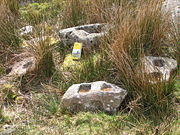
The characteristic indicator of a former stamping mill is the mortarstone. These are blocks of granite up to a metre long with flat faces bearing two, three or (rarely) four circular or elliptical hollows usually around 17 cm in diameter and up to about 10 cm deep. Many of these mortarstones have hollows on more than one face, showing that they were turned and reused once the hollows became too deep for effective stamping.
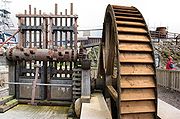
Concentration
Although individual grains or pebbles of alluvial tin collected by streaming were often of high purity it was usually still necessary to remove the unwanted "gangue" material before the ore could be smelted. The need for this process, which was known as dressing the ore, increased as the poorer sources of lode tin were exploited. The principle of concentration was a refined version of that used by the early tin-streamers: it depended on the large difference in specific gravitySpecific gravity
Specific gravity is the ratio of the density of a substance to the density of a reference substance. Apparent specific gravity is the ratio of the weight of a volume of the substance to the weight of an equal volume of the reference substance. The reference substance is nearly always water for...
between the wanted tin ore and the gangue. Many different mechanical methods were used, including rectangular and circular buddles, Wilfley tables and revolving slime tables, kieves, trommels, and even magnetic separation.
An early separation method was the rectangular buddle which was simply a slightly inclined plane over which the crushed material was washed by a gentle stream of water. The heavier ore would settle near the top of the incline while the lighter material would settle lower down or be washed off the buddle altogether. As there was a gradation in quality from the top to the bottom, the mineworker's skill lay in deciding where to make the dividing line between the wanted material and the waste. The division was often made in three parts: the "heads", which represented the best quality ore; the "middles", which was often reprocessed; and the "tailings", which was dumped.
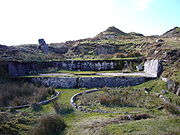
Smelting

The earliest method of liberating the metal from the tin ore necessitated two smeltings: the first was done at or near the streamworks and involved no more than a fire used to roast the ore; the second smelting was done at one of the Stannary towns
Stannary
The word stannary is historically applied to:*A tin mine, especially in Cornwall or Devon, South West England*A region containing tin works *A chartered entity comprising such a region, its works, and its workers...
. Little is known of the details of these practices, but their existence is confirmed by early documents that mention taxation of first and second smeltings. The introduction of the efficient blowing house
Blowing House
A blowing house or blowing mill was a building used for smelting tin in Cornwall and on Dartmoor in Devon, in South West England. Blowing houses contained a furnace and a pair of bellows that were powered by an adjacent water wheel, and they were in use from the early 14th century until they were...
process in around 1300 allowed the use of just one smelting. Later still reverberatory furnace
Reverberatory furnace
A reverberatory furnace is a metallurgical or process furnace that isolates the material being processed from contact with the fuel, but not from contact with combustion gases...
s were used. Both types were in use at Eylesbarrow mine
Eylesbarrow mine
Eylesbarrow mine was a tin mine on Dartmoor, Devon, England that was active during the first half of the 19th century. In its early years it was one of the largest and most prosperous of the Dartmoor tin mines, along with Whiteworks mine and the Birch Tor and Vitifer mines. Its name has several...
in the first half of the 19th century—the last place on Dartmoor where smelting was done.
Consequences
The effects of the large scale of early tin streaming were felt on the coast, as several harbours silted up due to the amount of fine material that was washed down the rivers. Because of this, in 1532 a Stannary Court decree ordained that all rubbish should be deposited in "old Hatches, Tipittes, miry Places, or other convenient Places" away from the main streams.The impact of mining on the Dartmoor landscape is still clear to see. Walkers on the moor will often stumble upon ruined blowing houses and mortar stones, featuring rows of semi-circular depressions, in which the ore was crushed. Many of the later mine shafts have now been filled in, but a few do still remain, fenced off to prevent walkers or animals from falling in.
Three hares symbol
The three haresThree hares
The three hares is a circular motif appearing in sacred sites from the Middle and Far East to the churches of southwest England , and historical synagogues in Europe....
is a circular motif which appears in sacred sites from the Middle
Middle East
The Middle East is a region that encompasses Western Asia and Northern Africa. It is often used as a synonym for Near East, in opposition to Far East...
and Far East
Far East
The Far East is an English term mostly describing East Asia and Southeast Asia, with South Asia sometimes also included for economic and cultural reasons.The term came into use in European geopolitical discourse in the 19th century,...
to the churches of south west England
England
England is a country that is part of the United Kingdom. It shares land borders with Scotland to the north and Wales to the west; the Irish Sea is to the north west, the Celtic Sea to the south west, with the North Sea to the east and the English Channel to the south separating it from continental...
(where it is often referred to as the "Tinners’ Rabbits"). It occurs with the greatest frequency in the churches of the West Country
West Country
The West Country is an informal term for the area of south western England roughly corresponding to the modern South West England government region. It is often defined to encompass the historic counties of Cornwall, Devon, Dorset and Somerset and the City of Bristol, while the counties of...
of England. The motif appears in architectural wood carving
Wood carving
Wood carving is a form of working wood by means of a cutting tool in one hand or a chisel by two hands or with one hand on a chisel and one hand on a mallet, resulting in a wooden figure or figurine, or in the sculptural ornamentation of a wooden object...
, stone carving
Stone carving
Stone carving is an ancient activity where pieces of rough natural stone are shaped by the controlled removal of stone. Owing to the permanence of the material, evidence can be found that even the earliest societies indulged in some form of stone work....
, window tracery
Tracery
In architecture, Tracery is the stonework elements that support the glass in a Gothic window. The term probably derives from the 'tracing floors' on which the complex patterns of late Gothic windows were laid out.-Plate tracery:...
and stained glass
Stained glass
The term stained glass can refer to coloured glass as a material or to works produced from it. Throughout its thousand-year history, the term has been applied almost exclusively to the windows of churches and other significant buildings...
. In South Western England there are nearly thirty recorded examples of the Three Hares appearing on 'roof bosses' (carved wooden knobs) on the ceilings in medieval
Middle Ages
The Middle Ages is a periodization of European history from the 5th century to the 15th century. The Middle Ages follows the fall of the Western Roman Empire in 476 and precedes the Early Modern Era. It is the middle period of a three-period division of Western history: Classic, Medieval and Modern...
churches in Devon, (particularly Dartmoor). There is a good example of a roof boss of the Three hares at Widecombe-in-the-Moor
Widecombe-in-the-Moor
Widecombe-in-the-Moor is a small village located within the heart of the Dartmoor National Park in Devon, England. . The name is thought to derive from 'Withy-combe' which means Willow Valley....
, Dartmoor, with another in the town of Tavistock on the edge of the moor.
Tinners' Rabbits is the name of a dance of many forms involving use of sticks and rotation of three, six or nine dancers.

